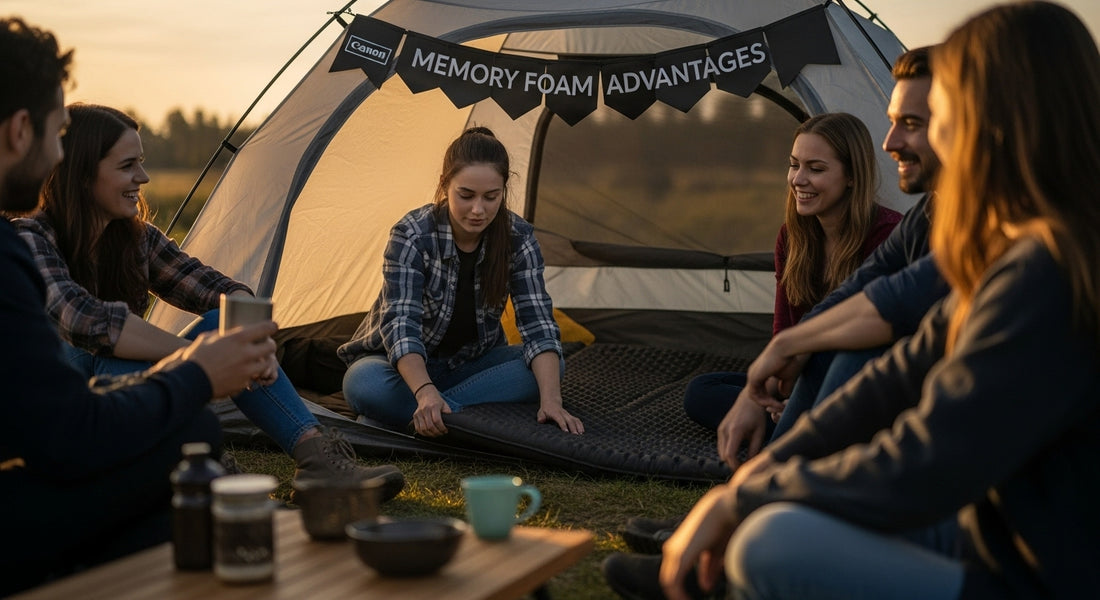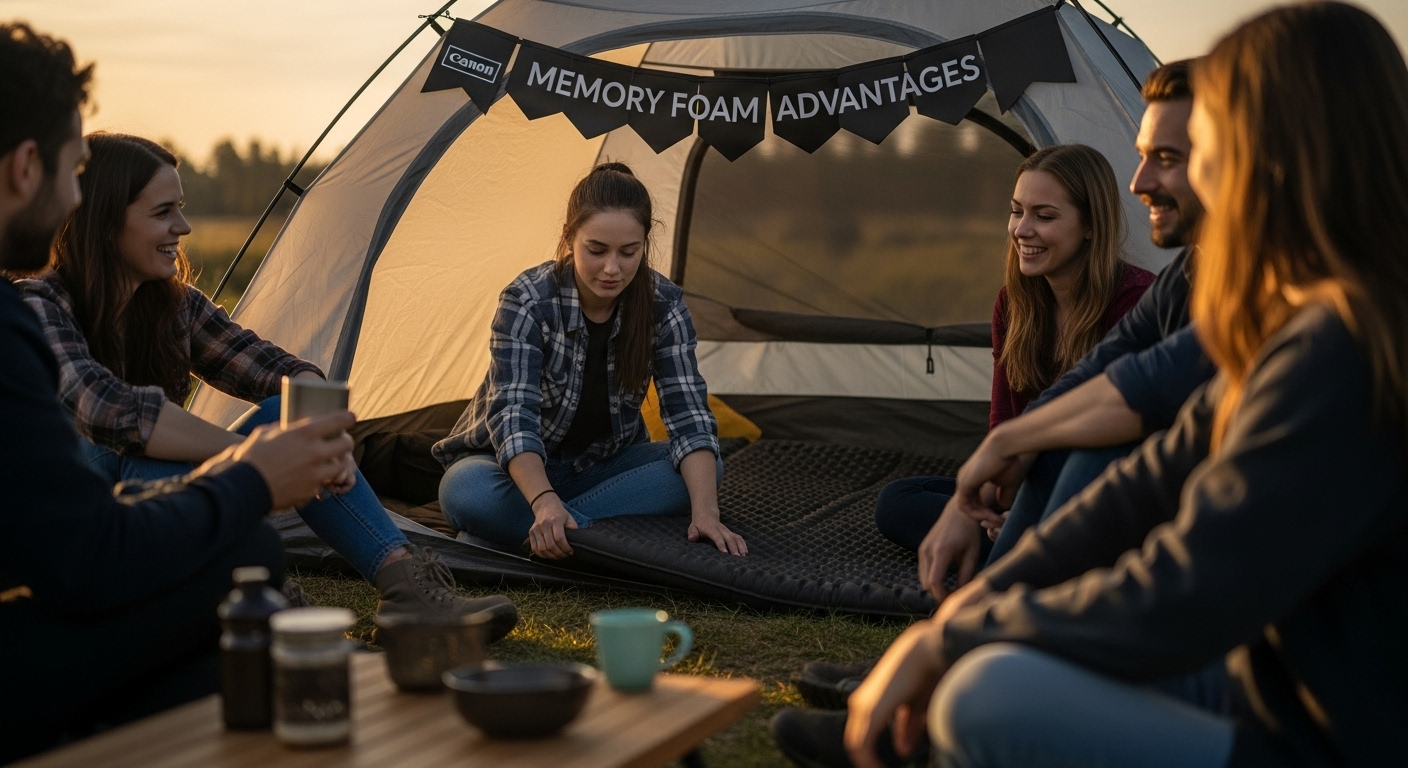
Memory foam started as a high-tech experiment for NASA, designed to absorb shock and support astronauts heading into space. Most people know it now for its famous, slow-rising comfort built into beds and pillows, but it turns out that memory foam’s true claim to fame goes way beyond the bedroom. NASA’s memory foam can actually maintain its shape and support in temperatures ranging from freezing cold to scorching heat which is why outdoor adventurers have turned this space-age material into their favorite portable comfort hack.
Table of Contents
- What Is Memory Foam And How Does It Work?
- The Importance Of Comfort In Outdoor Activities
- Key Advantages Of Memory Foam For Outdoor Use
- Real-World Applications Of Memory Foam Outdoors
- Comparing Memory Foam To Other Outdoor Cushioning Options
Quick Summary
| Takeaway | Explanation |
|---|---|
| Memory foam adapts to body shapes. | It molds precisely to contours, providing customized support during outdoor activities. |
| Temperature sensitivity enhances comfort. | Memory foam adjusts in firmness based on ambient temperatures, ensuring consistent comfort in various conditions. |
| Excellent pressure distribution reduces strain. | The material evenly spreads body weight, minimizing stress on muscles and joints during use. |
| Quick recovery maintains support over time. | After pressure removal, memory foam returns to its original shape, ensuring lasting comfort and effectiveness. |
| Versatile applications improve outdoor gear. | From sleeping pads to protective gear, memory foam enhances comfort and performance across multiple outdoor environments. |
What is Memory Foam and How Does It Work?
Memory foam represents an innovative material designed to transform how we experience comfort and support in various settings. Originally developed by NASA for spacecraft seat cushioning, this specialized polyurethane foam has revolutionized sleep technology and outdoor comfort solutions.
The Fundamental Science Behind Memory Foam
At its core, memory foam is a viscoelastic material composed of polyurethane mixed with specific chemical additives that dramatically alter its physical properties. These chemicals enhance the foam’s ability to respond to temperature and pressure, creating a unique material that can adapt and conform to external forces. According to research from the National Sleep Foundation, memory foam’s distinctive characteristic is its ability to mold precisely to body contours while distributing weight evenly.
The material’s molecular structure allows it to undergo remarkable transformations when exposed to heat and pressure. When you apply weight or body heat, the foam’s molecules begin to shift and spread, creating a custom-fitted impression that supports every curve and angle of your body. This dynamic response makes memory foam particularly valuable in outdoor contexts where comfort and adaptability are crucial.
Performance Characteristics in Outdoor Environments
Memory foam’s performance is not just about softness but about intelligent responsiveness. Key attributes that make it exceptional for outdoor use include:
- Temperature Sensitivity: Capable of adjusting firmness based on ambient temperature
- Pressure Distribution: Reduces stress points by evenly spreading body weight
- Quick Recovery: Returns to original shape after pressure is removed
Research from Materials Science journals demonstrates that memory foam’s viscoelastic properties make it resilient in varying environmental conditions. Whether you’re camping in cool mountain regions or relaxing on a warm beach, the foam adapts, providing consistent support and comfort.
Understanding memory foam’s science reveals why it has become a game changing material for outdoor enthusiasts seeking superior comfort solutions. Its ability to respond dynamically to individual body characteristics while maintaining structural integrity sets it apart from traditional cushioning materials.
The Importance of Comfort in Outdoor Activities
Comfort transcends mere physical pleasure when engaging in outdoor adventures. It represents a critical factor that directly influences performance, enjoyment, and overall experience in challenging environments. Understanding comfort’s role is essential for outdoor enthusiasts seeking to maximize their recreational and exploratory potential.
Psychological and Physical Impact of Comfort
Outdoor activities demand significant physical and mental resilience. Research from the International Journal of Environmental Research and Public Health reveals that physical comfort plays a pivotal role in psychological well-being during outdoor experiences. When individuals feel physically supported and comfortable, their mental endurance and overall engagement dramatically improve.
The human body experiences stress and fatigue more rapidly in unfamiliar or challenging environments. Proper comfort mechanisms like advanced cushioning, temperature regulation, and ergonomic support can mitigate these challenges. By reducing physical strain, comfort enables outdoor enthusiasts to extend their activities, maintain higher energy levels, and enjoy more immersive experiences.
Key Comfort Factors in Outdoor Settings
Multiple interconnected elements contribute to comprehensive outdoor comfort:
- Physical Support: Minimizing muscular strain and joint pressure
- Temperature Management: Maintaining consistent body temperature
- Psychological Resilience: Reducing mental stress through physical ease
- Adaptability: Responding to changing environmental conditions
These factors work synergistically to create an optimal outdoor experience. According to experts in Sport and Exercise Psychology, comfort is not just about physical sensation but about creating an environment where individuals feel secure, supported, and capable of pushing their personal boundaries.
Beyond immediate physical benefits, comfort in outdoor activities contributes to long-term engagement. When people experience positive, comfortable interactions with challenging environments, they are more likely to develop sustained interest in outdoor pursuits. Memory foam and similar advanced materials represent technological innovations that directly address these comfort requirements, transforming how we approach and enjoy outdoor experiences.
Key Advantages of Memory Foam for Outdoor Use
Memory foam represents more than just a comfortable material. Its unique engineering makes it an exceptional solution for outdoor enthusiasts seeking reliable, adaptive comfort across diverse environmental conditions. Understanding its specific advantages reveals why this material has become increasingly popular among adventurers and outdoor recreationists.
Performance and Durability in Challenging Environments
According to NASA’s original research documentation, memory foam was engineered to withstand extreme conditions while providing superior support. In outdoor settings, this translates to remarkable performance characteristics that traditional materials cannot match. The foam’s ability to absorb and redistribute pressure means reduced physical strain during extended activities like hiking, camping, and long-distance travel.
The material’s molecular structure allows it to maintain structural integrity across temperature variations. Whether experiencing cold mountain nights or hot desert afternoons, memory foam maintains its supportive properties. This adaptability ensures consistent comfort, making it an ideal choice for outdoor equipment like sleeping pads, camping chairs, and portable cushions.
This table organizes the main advantages of memory foam for outdoor use as highlighted in the article, providing a concise reference for its performance and comfort benefits.
| Advantage | Description |
|---|---|
| Pressure Point Reduction | Minimizes muscle and joint stress during prolonged use |
| Weight Distribution | Evenly spreads body weight for improved comfort |
| Quick Recovery | Returns to original shape after compression |
| Temperature Responsiveness | Maintains consistent support regardless of climate |
| Hypoallergenic Properties | Resists dust, mites, and environmental allergens |
| Lightweight Portability | Offers high comfort without adding excessive weight |
| Personalized Support | Conforms to body contours for tailored comfort |
Unique Comfort and Health Benefits
Memory foam offers several critical advantages for outdoor enthusiasts:
- Pressure Point Reduction: Minimizes muscle and joint stress
- Weight Distribution: Evenly spreads body weight for improved comfort
- Quick Recovery: Returns to original shape after compression
- Hypoallergenic Properties: Resists dust, mites, and environmental allergens
Research from the Polyurethane Foam Association highlights that memory foam’s dense structure provides exceptional support while maintaining lightweight characteristics. This means outdoor gear can remain portable without compromising comfort or performance.
Moreover, memory foam’s ability to conform to individual body contours provides personalized support. This characteristic is particularly valuable in outdoor scenarios where physical comfort directly impacts overall experience and endurance. By reducing physical stress and promoting better body alignment, memory foam enables outdoor enthusiasts to extend their adventures and enjoy more comfortable, sustained experiences in challenging environments.
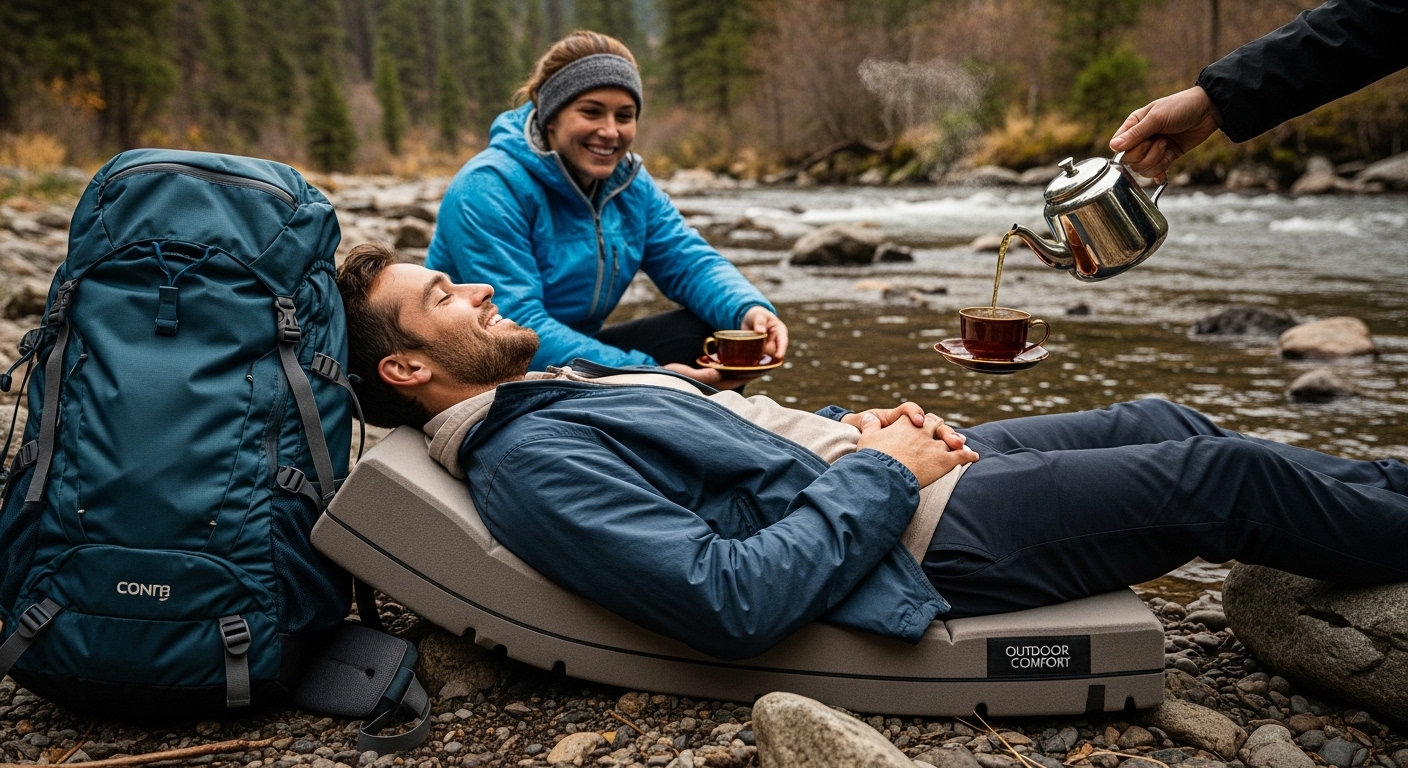
Real-World Applications of Memory Foam Outdoors
Memory foam’s versatility extends far beyond traditional sleeping surfaces, emerging as a transformative material for outdoor enthusiasts seeking innovative comfort solutions. From camping gear to protective equipment, its unique properties enable remarkable adaptations across diverse recreational environments.
Camping and Portable Equipment Innovation
According to NASA’s original research documentation, memory foam’s initial development for aerospace applications has seamlessly translated into outdoor recreational technologies. Camping equipment manufacturers have embraced this material to create lightweight, compact, and supremely comfortable gear that dramatically enhances outdoor experiences.
Modern camping innovations utilizing memory foam include ultralight sleeping pads, compact chair cushions, and portable mattress toppers. These products leverage memory foam’s ability to compress significantly while maintaining structural integrity, allowing adventurers to carry high-performance comfort solutions without added bulk. The material’s temperature-responsive properties ensure consistent support across varying environmental conditions, from chilly mountain nights to warm desert evenings.
Specialized Outdoor Performance Applications
Memory foam’s adaptability extends into specialized outdoor performance domains
:
- Hiking Backpack Straps: Reducing shoulder and back strain
- Protective Gear Padding: Absorbing impact in extreme sports
- Emergency Rescue Equipment: Providing lightweight, responsive cushioning
- Portable Shelter Insulation: Offering thermal regulation
These applications showcase memory foam’s extraordinary capacity to address complex ergonomic challenges. Research from the National Academies Press highlights how advanced foam materials can provide superior performance in demanding environments.
Beyond recreational use, memory foam’s potential in outdoor applications continues to expand. Its remarkable ability to distribute pressure, adapt to body contours, and maintain structural resilience makes it an increasingly essential material for adventurers seeking sophisticated comfort solutions in challenging outdoor settings.
Comparing Memory Foam to Other Outdoor Cushioning Options
Choosing the right cushioning material can significantly impact comfort and performance during outdoor activities. While multiple options exist, memory foam stands out for its unique combination of adaptive support and innovative design, offering distinct advantages over traditional cushioning alternatives.
Performance Characteristics and Material Differences
Research from the Journal of Physical Therapy Science reveals critical differences between cushioning materials. Memory foam distinguishes itself through superior pressure redistribution and body contouring capabilities. Unlike traditional foam or inflatable options, memory foam dynamically responds to body heat and weight, creating a personalized support surface that adapts to individual physical characteristics.
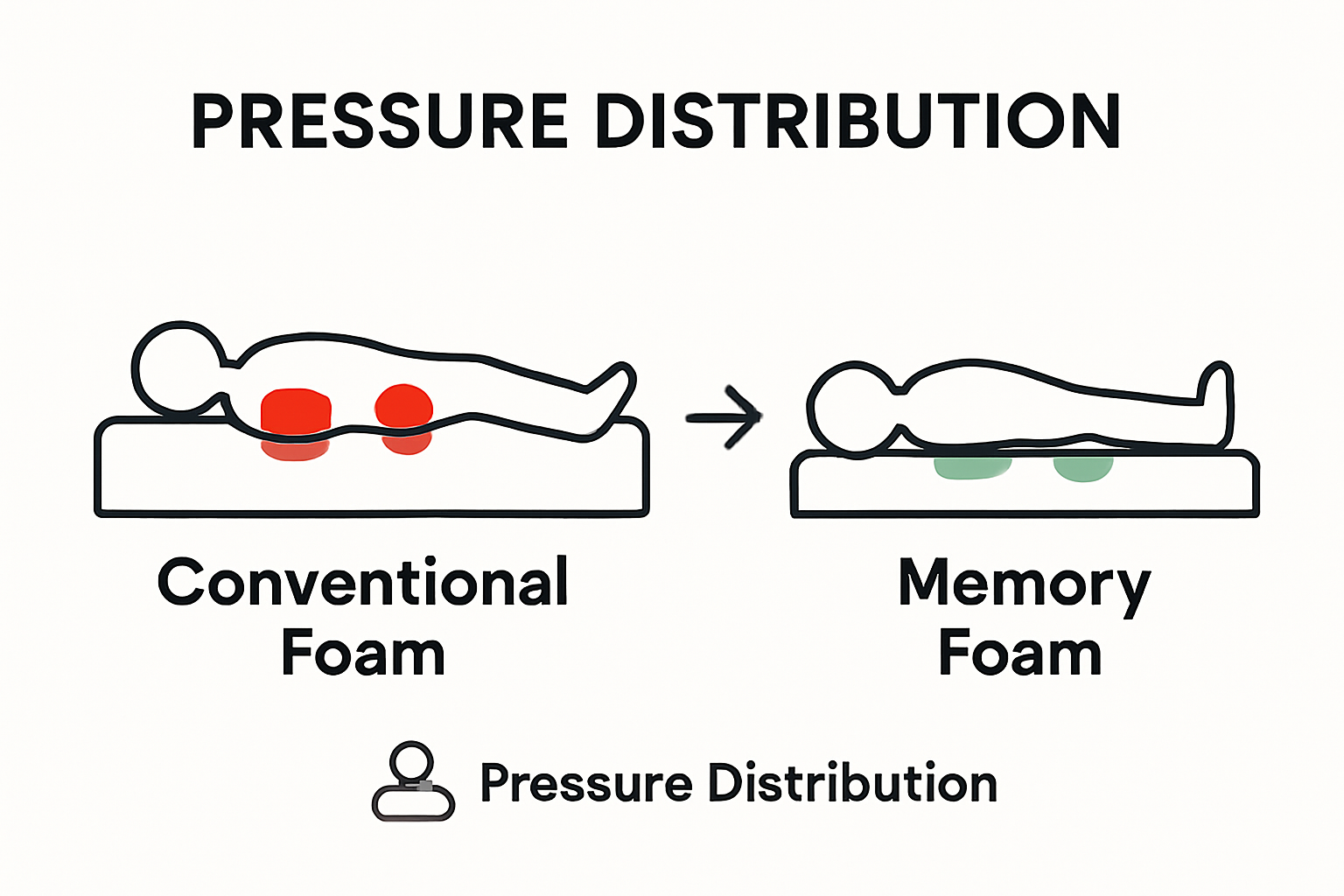
Traditional outdoor cushioning materials like polyurethane foam, air-filled cushions, and gel pads each present unique limitations.
To help readers compare outdoor cushioning materials, the following table summarizes key performance and feature differences between memory foam, standard foam, air-filled cushions, and gel pads as discussed in the article.
| Material Type | Pressure Distribution | Durability in Outdoor Conditions | Temperature Responsiveness | Compressibility/Portability |
|---|---|---|---|---|
| Memory Foam | Excellent, adapts to body | Maintains structure across environments | Adjusts firmness with climate | Compresses well, remains supportive |
| Standard Foam | Poor, compresses unevenly | Quickly loses structure over time | Minimal responsiveness | Bulky, loses loft under pressure |
| Air-Filled Cushion | Variable, depends on inflation | Prone to punctures or leaks | No adaptive properties | Highly portable but may deflate |
| Gel Pad | Inconsistent support | Can shift or leak; less resilient | Limited, cool to touch only | Usually less compact, heavier |
Comparative Advantages and Considerations
Key comparative factors for outdoor cushioning materials include:
- Durability: Memory foam’s dense molecular structure resists breakdown
- Weight Distribution: Superior pressure point reduction compared to alternatives
- Temperature Responsiveness: Maintains consistent performance across environments
- Compressibility: Enables more compact storage for outdoor gear
While alternative materials like natural latex or specialized elastic woods offer interesting properties, they often cannot match memory foam’s comprehensive performance profile. The material’s ability to provide consistent support, absorb impact, and return to its original shape makes it particularly valuable for outdoor enthusiasts seeking reliable comfort solutions.
Ultimately, memory foam represents a sophisticated approach to outdoor cushioning. Its engineering goes beyond simple padding, offering a scientifically designed solution that actively responds to user needs. For adventurers and outdoor enthusiasts seeking maximum comfort with minimal compromise, memory foam provides an unparalleled combination of support, adaptability, and performance.
Experience Superior Outdoor Comfort with Hazli Memory Foam Solutions
After learning how memory foam adapts to your body and withstands the demands of the outdoors, it is clear that achieving true comfort is essential for every adventure. If you have ever struggled with poor sleep while camping or felt that thin mats and regular foam just cannot support you, you are not alone. The article highlights the need for pressure relief, temperature sensitivity, and lasting durability—essential qualities that set memory foam apart from ordinary outdoor gear.
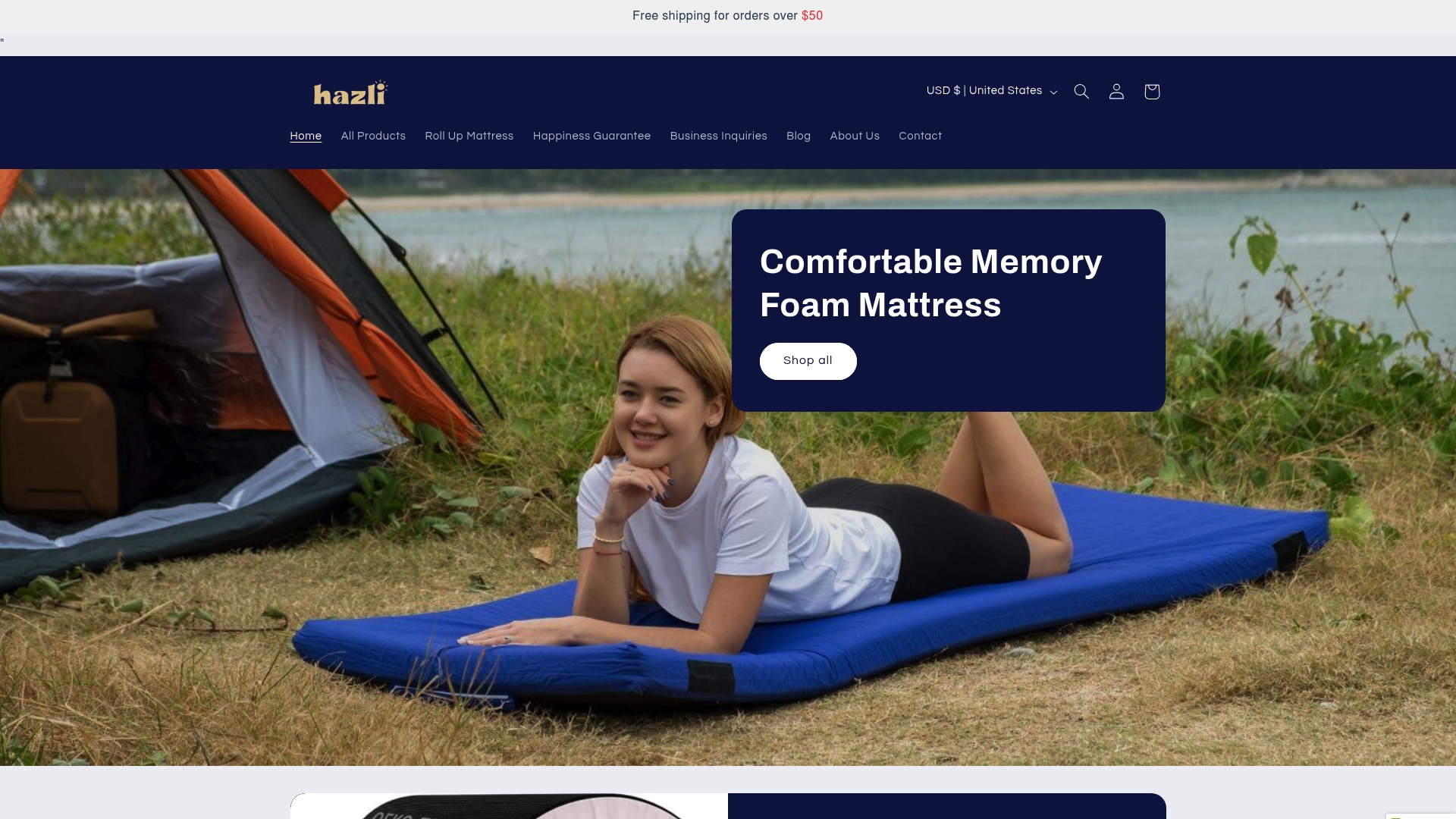
Let Hazli Collection help you redefine your outdoor sleep experience. Our outdoor memory foam mattresses and camping gear give you the supportive rest and long-lasting reliability you need for any trip. Every product is designed for comfort and resilience, allowing you to wake up refreshed in any environment. Do not let another night of discomfort hold you back. Visit Hazli Collection today to find the perfect memory foam solution for your next outdoor adventure. Discover what it feels like to sleep well under the stars—shop now and experience the difference first-hand.
Frequently Asked Questions
What is memory foam and how does it work outdoors?
Memory foam is a viscoelastic material that responds to temperature and pressure, allowing it to conform to the body’s contours. This feature makes it ideal for outdoor use, as it provides support and comfort in varying environments.
What are the benefits of using memory foam for outdoor activities?
Memory foam offers several advantages for outdoor enthusiasts, including pressure point reduction, excellent weight distribution, temperature responsiveness, and durability in challenging conditions. These benefits enhance overall comfort and performance during outdoor adventures.
How does memory foam compare to other outdoor cushioning options?
Memory foam outperforms traditional cushioning materials like standard foam or air-filled cushions by offering superior pressure redistribution, durability, and adaptability to body shapes. Unlike alternatives, it maintains its structural integrity and comfort across various environmental conditions.
Can memory foam help improve comfort during long outdoor adventures?
Yes, memory foam significantly enhances comfort during extended outdoor activities by reducing muscular strain and promoting better body alignment. Its ability to adapt to body contours helps prevent fatigue and enables adventurers to enjoy longer and more immersive experiences.

